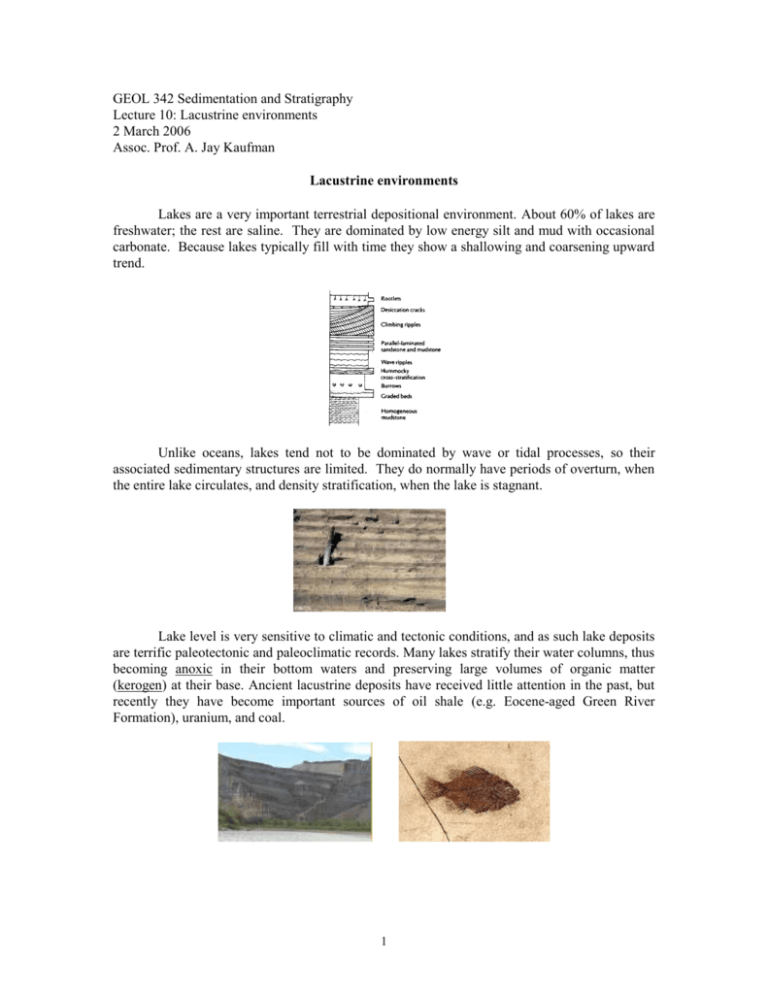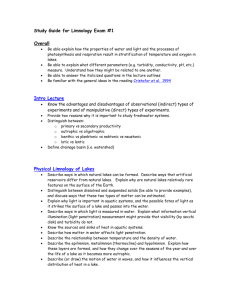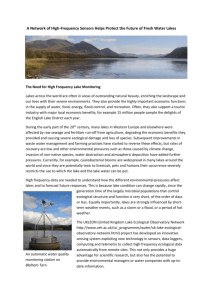Lakes
advertisement

GEOL 342 Sedimentation and Stratigraphy Lecture 10: Lacustrine environments 2 March 2006 Assoc. Prof. A. Jay Kaufman Lacustrine environments Lakes are a very important terrestrial depositional environment. About 60% of lakes are freshwater; the rest are saline. They are dominated by low energy silt and mud with occasional carbonate. Because lakes typically fill with time they show a shallowing and coarsening upward trend. Unlike oceans, lakes tend not to be dominated by wave or tidal processes, so their associated sedimentary structures are limited. They do normally have periods of overturn, when the entire lake circulates, and density stratification, when the lake is stagnant. Lake level is very sensitive to climatic and tectonic conditions, and as such lake deposits are terrific paleotectonic and paleoclimatic records. Many lakes stratify their water columns, thus becoming anoxic in their bottom waters and preserving large volumes of organic matter (kerogen) at their base. Ancient lacustrine deposits have received little attention in the past, but recently they have become important sources of oil shale (e.g. Eocene-aged Green River Formation), uranium, and coal. 1 Different kinds of lakes are found in different climates, but desert, temperate, Mediterranean, and even arctic zones have large lakes. This discussion will focus on large, permanent lakes, as opposed to small ephemeral lakes or ponds. Recognition In the modern, weak currents characterize most lakes. As such, laminated fine-grained deposits dominate all but the margins of ancient lake deposits. They are commonly characterized by a low abundance, low diversity fauna. They are commonly sandwiched between other types of deposits (the lake sandwich), like fluvial or aeolian successions. Classification Lakes can be subdivided into two main categories based on their water level. The next subdivision involves lake chemistry. Importantly, lake character can vary a lot over short time scales. As such, rather different kinds of lake deposit can occur in close succession (e.g., interbedded fresh vs. saline). Name Open Lake (Water & sediment flux high, water can leave) Closed Lake (Water & sediment flux lower, water cannot leave) Water character Stratified Mixed Special deposits Organic-rich shales ---- Fresh Saline Organic-rich shales Carbonates, evaporites Lakes are most common in areas of internal drainage, where a closed basin accumulates water. Thhey are found in regions of 1) tectonic depression (e.g. rift grabens), 2) volcanic calderas, 3) glacial depressions, 4) karst sinkholes, 5) meteorite craters, or 5) impounded water behind some geological or man-made barrier. Water Water can enter a lake through three means: rain, groundwater, and rivers. Usually, it only leaves by evaporation, but may also have rivers flowing out as well. Thus, lakes have a water budget as to whether or not the lake is receiving more water than it loses. If a lake is open (water leaves by surface flow), the lake height will be fixed by a topographic saddle called a sill. Sills usually maintain a relatively constant height over 100,0001,000,000 yr. time scales, but they may also spontaneously fail, resulting in very large flood events. 2 Chemistry Where the clastic input to the lake is limited, chemical sedimentation may predominate, including evaporites and carbonates. Where evaporation exceeds inflow the salinity can become greater than the oceans. As evaporation proceeds and lake level falls carbonate, gypsum, and halite are sequentially precipitated, and these may be followed by potassium and magnesium salts. Tufa spires are common in closed lakes where evaporation is great. However, most lacustrine carbonates form in environments where there is not great evaporation, but fluctuations in pH. They typically contain ample carbonate ion from the dissolution of surrounding bedrock, and are in general equilibrium with atmospheric CO2. Changes in pH induced by plant growth and warming, which affect the CO2 concentration in the lakes. The mixture of siliciclastic mud and carbonate in lakes produce the sediment type known as marl. Characteristic carbonate accumulations include oncolites or algal biscuits formed by freshwater calcareous algae. associated deposits/environments Alluvial fans/Fan Deltas: These will be found right at the edge of the lake against the active rangefront. Fan deltas are alluvial fans that build into standing water and are very similar in character Deltas: These can be found building at the edge of the lakes, often in an axial position. These can be coarse or fine grained. As lake-level varies quickly, deltas can step forwards, backwards, or be abandoned very quickly. As such, deltaic deposits can interfinger with lake center sort of sediments “Gilbert Deltas”: These are very steep, coarse-grained deltas that build incrementally into the lake. These deltas exist at the angle of repose for coarse sediment, often 10º-20º. Gilbert deltas form where glacial streams meet the deep proglacial lake. They have horizontal topset beds and south-dipping foreset beds. In front of the foreset beds are shallow horizontal bottomset beds. 3 Rivers: As lake level drops, various kinds of rivers can occupy the old lake beds. These are typically flashy, shallow channels with small loads that make a kind of “sand flat” environment. Lake-floor fans: In lakes of good depth (>200 m), lakes may behave a bit like deep-sea systems and develop basinal turbidite fans along the lake floor. These are similar to deep-water fans, but are commonly more thinly bedded and a bit muddier. 4









